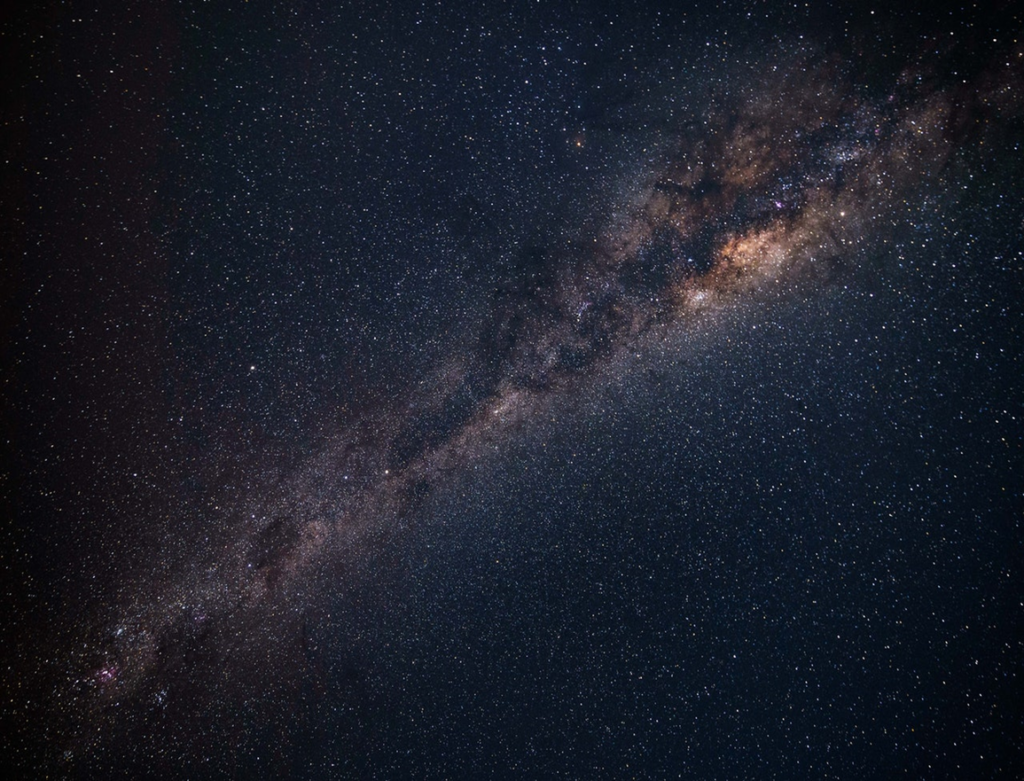
I learned this today. Dark matter is a hypothetical matter in space that doesn’t absorb, emit or reflect light, yet has gravity and keeps the universe together.
It is theorized that dark matter makes up 27% of the universe. The part that we can see, the ordinary matter, only makes up about 5%.
If dark matter is basically invisible, how can anyone know that it is there? There are four main ways that it can be shown.
Firstly, the speed with which outer bodies orbit the center of a galaxy is off. Gravity decreases with distance. If you look at our solar system, you can see this clearly. The sun has most of the mass and the inner planets, Mercury, Venus, and Earth orbit around it far more quickly than the outer planets, Saturn, Uranus, and Neptune. The farther away from the center of mass a body is, the slower it will orbit.
This should apply to anything orbiting a center of mass. However, it doesn’t seem to work with galaxies. Astronomers looked at a galaxy and they assumed that the bright part at the center of the galaxy was the area of most mass that the rest of the galaxy was orbiting around. At the edge of the galaxy, where there is less mass, the objects should be orbiting more slowly, as with Neptune. When scientists calculated the velocities of the stars vs their distances from the galactic center, they discovered that they were moving much too fast. The only way to explain it is that they have far more mass that we just can’t see. Dark matter.
Secondly, galaxies do not fly apart. Astronomers looking at galaxies calculated that they were rotating too quickly for the visible mass to stay together. If all the mass present was the mass that we could see, then there wouldn’t be enough mass to keep them together and galaxies would break apart, their outer parts would be flung into space. The fact that wasn’t happening meant there had to be more matter giving mass to the outer bodies that we could not see. This must be dark matter.
Thirdly, the way astronomers calculate the mass of galaxies gives a discrepancy. There are two ways to calculate the mass of a galaxy. The first way is by using the velocity of the galaxy. This is done by looking at how much the wavelength of the light coming from the galaxy has shifted. When a galaxy is moving away from us, its wavelength shifts into the red spectrum and when it is moving towards us it shifts into the blue. The wavelength corresponds to the speed. The second way to calculate the mass is to look at the total brightness of the galaxy. In 1933, Fritz Zwicky made these two calculations and came up with two different results. The galaxy was moving faster than the visible mass allowed for. The only answer was dark matter.
Fourthly, dark matter bends light. Light is bent by gravity as it travels through space and the amount of the bend depends on the mass of the object. This is called gravitational lensing. Our sun would bend light a little, while a black hole bends light so much that the light is trapped. Using this theory, it is possible to calculate the mass of an object by looking at how light bends as it passes it. Using gravitational lensing astronomers looked at the Bullet Cluster, which is two galaxies that recently collided. They realized that the center of mass for the new galaxy was far away from where it should be if visible mass alone was accounted for. The only explanation was dark matter.
What could dark matter be? Well, nobody knows. There are four main theories. The first one is that it is made up of neutrinos, which also do not emit light. They have no charge and do not interact with other particles. However, they have almost zero mass and are too light to account for all of this dark matter. The second theory is WIMPs (Weakly Interacting Massive Particles). They are a theoretical particle that interact with objects via gravity. They would weigh about 100 times more than a proton. The third theory is atom sized black holes that formed at the very beginning of the universe. However, these would emit Hawking radiation, and none has been detected. The last theory is that there is actually no dark matter. There is the possibility that everything we know about gravity and the laws of physics astronomers are making these calculations on are somehow incorrect. If this is the case, it is going to take something spectacular to set everything straight. Maybe another Einstein is needed.
If dark matter does exist, it cannot be detected in experiments here on Earth, but it could be detected by not being detected. If an experiment at the Large Hadron Collider comes up with some missing and undetected matter and energy at the end, there is a good chance that this is dark matter.
So, dark matter makes up a large percentage of the universe. It doesn’t reflect or emit light in anyway, so is completely undetectable. It can be theorized to exist because of the effects it has on other celestial bodies. And this is what I learned today.
Photo by Philippe Donn from Pexels
Sources
https://en.wikipedia.org/wiki/Dark_matter
https://en.wikipedia.org/wiki/Bullet_Cluster
https://www.space.com/20930-dark-matter.html
https://science.nasa.gov/astrophysics/focus-areas/what-is-dark-energy
https://home.cern/science/physics/dark-matter
https://www.livescience.com/dark-matter.html
https://starchild.gsfc.nasa.gov/docs/StarChild/universe_level2/darkmatter.html
https://kids.frontiersin.org/articles/10.3389/frym.2021.576034
https://depts.washington.edu/astroed/HubbleLaw/measurements.html
https://www.physicsclassroom.com/class/circles/Lesson-3/Newton-s-Law-of-Universal-Gravitation
https://en.wikipedia.org/wiki/Weakly_interacting_massive_particles

